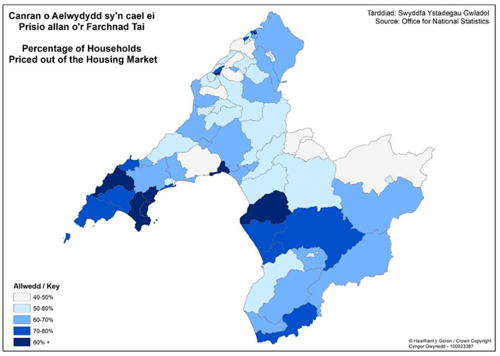30 Jun 2025
Rural housing and second homes in Wales
CIH Cymru’s policy and public affairs manager Cerys Clark explores the impact of high density areas of second homes where not enough homes at social rent are being built.
Wales is home to three national parks and five areas of outstanding national beauty. These areas and our many historical sites are promoted by Visit Wales to boost tourism. Tourism in Wales accounts for 11.8 per cent of employment, and in 2022 added around £3.8 million to the economy, mainly at a local level. Tourism also helps foster small businesses and enterprises to maximise the opportunities tourism provides across Wales. Yet despite these positives, one downside, for the locals, of booming tourism is the rise in second home ownership.
The 2021 Census showed that the number of second addresses used as holiday homes in Wales was 6.9 per 1,000 dwellings. The only region in England higher than this was the South West. Yet the number of second homes is much higher in Wales’ nine rural local authorities. These local authorities are Ynys Môn, Gwynedd, Conwy, Denbighshire, Powys, Ceredigion, Pembrokeshire, Carmarthenshire and Monmouthshire.
At a local authority level, Gwynedd has 41 second address holiday homes per 1,000 dwellings and Ynys Môn 32.9 per 1,000. These two local authorities are amongst the four local authorities with the highest rate across England and Wales. This high concentration of second homes has been linked to increasing unaffordability of homes for those wanting to remain in their local area. Research commissioned by Gwynedd council has shown that a large proportion of the local authority area is now unaffordable for those wanting to set up home in the area as shown on the following map:

On average 59.6 per cent of local people in Gwynedd are currently priced out of the housing market.
Another concern for these rural areas with a high proportion of second homes is the impact it’s having on the Welsh language. In Gwynedd, 64.4 per cent speak Welsh and on Ynys Môn 55.8 per cent speak Welsh. One of the Wellbeing of Future Generations (Wales) Act 2025 seven wellbeing goals is a ‘Wales of Vibrant Culture and Thriving Welsh Language’. Concerns have been raised that as homes in these areas remain unaffordable, young Welsh speakers are moving out of the area.
Some measures have already been introduced by Welsh government to tackle second home use. Local authorities have been given the power to introduce discretionary council tax premiums on second homes of up to 300 per cent. In addition, Gwynedd Council, as part of the Dwyfor pilot, can now require planning permission to be obtained before changing the use of a residential home to a second home or holiday home. The latest house price data for Gwynedd shows the impact of this change with the average house price down 5.2 per cent. The house price paid by first time buyers was £167,000. This was 4.7 per cent lower that the average of £175,000 in December 2023.
This reduction in house prices has started to improve affordability for those looking to buy a home in their local area but this cannot be the only solution to the unaffordability of homes in rural Wales. We also need to be developing affordable homes at pace and scale.
Welsh government has over the last Senedd term provided record levels of investment in order to meet the target of delivering 20,000 homes at social rent by 2026. Yet by March 2024 just 8,074 homes had been delivered, less than half of the 20,000 target, with two years left in the programme.
Audit Wales, in its latest report on affordable housing, has estimated that an additional £580 million to £740 million could be needed on top of existing budget assumptions to deliver all the homes currently in the development pipeline. Without this additional investment, just 15,860 to 16,670 homes could be delivered by March 2026, well short of the target.
Furthermore, the Senedd’s Local Government and Housing Committee has stated we will need to develop 60,000 homes to rebalance housing tenure and affordability of our homes in Wales. This increase in the number of homes we develop will help rebalance tenure across Wales, which in turn will help address the affordability of our homes across Wales especially for our rural communities.
That is why ahead of the 2026 Senedd election we are asking the next Welsh government to commit to more social and affordable homes. Part of this must be tackling second homes which are undermining the supply of affordable homes in rural Wales.
To find out more, read the CIH Cymru Manifesto for 2025/26.


